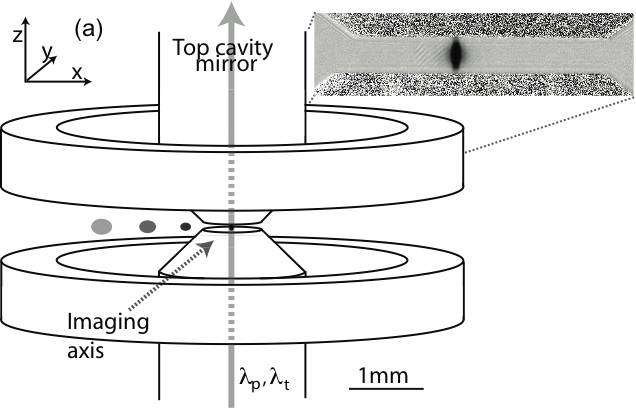Research
- E3: cQED, Optomechanics
- E4: Collective modes
of spinor gases - E5: Optical Kagome Lattice
- E6: cQED, Optical lattice Retired Experiments
- E1: Spinor Rubidium BEC
- E2: Cavity QED
Group Information
- People
- Publications
- Theses
- Presentations
- Research Highlights
- Popular Coverage
- Lab news
- Undergraduate research
Links
- January 2016 MURI Review Meeting
- Useful Links
- Review Papers
- Ultracold Coffee Hour
- Bitbucket: AMO@Berkeley
- Our Old Website
- AMO Seminar (PHYS 290F)
E2: Cold Atomic Ensembles in the Strong Coupling Regime of Cavity QEDCavity QED to date has yielded many tantalizing results, including the creation of atom-photon entanglement, single-atom microscopy, and long-lived optical trapping of a single atom in a resonant optical cavity. Incorporating the long lived motional coherence of ultacold atoms should yeild new possibilities for physical studies and quantum control. To implement this, we have constructed a novel mm-scale magnetic trap (pdf) to cool and tightly confine magnetically-trapped, ultracold atoms in an optical cavity. We affectionately call it the "millitrap." In practice we use these mm-scale electromagnets to form a time-orbiting potential (TOP) trap, in which we may form BECs of ~40,000 atoms.  The electromagnets are coaxial and surround a high-finesse optical Fabry-Perot cavity of 194 Ám length. We trap atoms in the mode of the cavity with a Far off resonant optical standing wave at 850 nm. This laser is also used to stabilize the length of the cavity. Atoms occupy ~300 lattice sites in the cavity, and have a temperature of ~800 nK. Dispersive Cavity QED: We probe the cavity dispersively ~10-100GHz from the 87Rb atomic resonance. In this limit the presence of each atom contributes a small amount of dispersive material to the cavity, changing the index of refraction. Nonlinear OpticsNonlinear optical phenomena typically occur at high optical intensities, as conventional materials mediate only weak coupling between photons. Under the condition of strong coupling, atomic saturation leads a host of nonlinear effects. In this system we observe significant nonlinearity due to collective motion of the atomic medium The Fluctuation BolometerIn a cavity, the density of states of the electromagnetic field is altered by the boundary conditions which the mirrors impose. Here, temporal fluctuations then take on the spectrum of the electromagnetic vacuum, being accentuated near the cavity resonances, and suppressed away from the resonances. Using the ultracold atomic medium in the cavity we have performed a Measurement of quantum fluctuations of radiation pressure. This measurement also constitutes the first quantification of quantum-measurement backaction on a macroscopic object that is consistent with quantum metrology limits. Cavity Opto-Mechanics with Ultracold AtomsBoth results above point to a description of atomic motion with a high-finesse optical resonator in terms of cavity opto-mechanics. In opto-mechanical systems, the motion of a mechanical object is sensed by, influenced by, and used orchestrate the interaction with an optical field. The mechanical systems employed in cavity opto-mechanical systems being explored in modern laboratories span an enormous range of scales -- from the atomic scale in experiments with trapped ions or cold atoms to the kilogram scale utilized in gravity wave detectors. A common goal for such experimental developments is the attainment of the quantum limits for controlling and detecting the state of the mechanical system. Our group has developed the idea that a large gas of cold atoms can serve as the mechanical element in such a cavity opto-mechanical system. This approach to opto-mechanics benefits from having immediate access to the quantum regime, owing to the ultralow temperatures of such gases, and having a direct theoretical connection to basic quantum optics and atomic physics. Moreover, the cold-atom systems are unique in reaching the granular regime, where single photons and single vibrational excitations of the mechanical system are strongly relevant. The connection between collective atomic motion and opto-mechanics is outlined in our paper on quantum-measurement backaction and in our ICAP Proceedings paper. Please see our recent publications and presentations to get the latest info on what we're up to! |
| Recent Changes (All) | Edit SideBar | Page last modified on April 11, 2016, at 02:08 PM | Edit Page | Page History |
| Powered by PmWiki | ||

